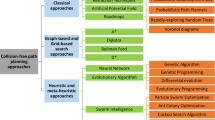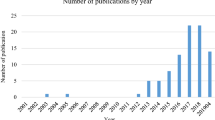Abstract
To ensure the smooth operation of each joint and shorten the joint movement time of a rail inspection robot, a trajectory planning method based on time optimization with a penalty function is proposed. According to the Denavit-Hartenberg (D-H) model of the inspection robot, a kinematic solution is found, and the trajectory of each joint is generated using a mixed polynomial interpolation algorithm. Taking time optimization as the standard, the traditional particle swarm algorithm cannot handle complex constraints, easily falls to local optimum solutions, and has a slow convergence speed. An improved simulated annealing particle swarm algorithm with a penalty function (IPF-SA-PSO) is proposed to optimize the trajectory generated by the mixed polynomial interpolation algorithm. The simulation results show that the proposed algorithm, compared with the mixed polynomial interpolation method, can limit the angular velocity and reduce the running time of each manipulator joint. The two algorithms are experimentally verified based on a rail inspection robot, and the results show that after adopting the optimization algorithm, the angular velocity of each joint is within the angular velocity limit, the run time is shorter, and the operation is smoother, which indicates the effectiveness of the proposed algorithm. The proposed algorithm can optimize the robot running time, improve the smoothness, and be applied to the fields of the automatic tracking of abnormal targets and video acquisition.
Similar content being viewed by others
References
S. N. Zhang, J. Y. Tian, and J. Long, “Research on multi-source and multi-period grey-evidential fusion evaluation model of porcine abnormal behaviors,” Heilongjiang Animal Science and Veterinary, no. 12, pp. 37–41, 2021.
K. B. Shi, J. Wang, Y. Y. Tang, and S. M. Zhong, “Reliable asynchronous sampled-data filtering of T–S fuzzy uncertain delayed neural networks with stochastic switched topologies,” Fuzzy Sets and Systems, vol. 381, pp. 1–25, 2020.
L. F. Hua, H. Zhu, K. B. Shi, S. M. Zhong, Y. Q. Tang, and Y. J. Liu, “Novel finite-time reliable control design for memristor-based inertial neural networks with mixed time-varying delays,” IEEE Transactions on Circuits and Systems I: Regular Papers, vol. 68, no. 4, pp. 1599–1609, 2021.
X. Cai, K. B. Shi, S. M. Zhong, J. Wang, and Y. Q. Tang, “Dissipative analysis for high speed train systems via looped-functional and relaxed condition methods,” Applied Mathematical Modelling, vol. 96, pp. 570–583, 2021.
S. Y. Zhang, A. M. Zanchettin, and R. Villa, “Real-time trajectory planning based on joint-decoupled optimization in human-robot interaction,” Mechanism and Machine Theory, vol. 144, pp. 1–22, 2020.
H. Wang, H. Wang, and J. H. Huang, “Smooth point-to-point trajectory planning for industrial robots with kine-matical constraints based on high-order polynomial curve,” Mechanism and Machine Theory, vol. 139, pp. 284–293, 2019.
W. F. Xu, C. Li, and X. Q. Wang, “Study on non-holonomic Cartesian path planning of a free-floating space robotic system,” Advanced Robotics, vol. 23, no. 1, pp. 113–143, 2012.
W. J. Wang, T. Qing, and Y. T. Cao, “Robot time-optimal trajectory planning based on improved cuckoo search algorithm,” IEEE Access, vol. 8, pp. 86923–86933, 2020.
M. M. Wang, J. J. Luo, and U. Walter, “Trajectory planning of free-floating space robot using particle swarm optimization (PSO),” Acta Astronautica, vol. 112, pp. 77–88, 2015.
G. H. Yang, H. Lee, and Y. S. Ryuh, Development of a 3-DOF Fish Robot ‘ICHTHUS V5’, 2013.
X. R. Xu, X. G. Wang, and F. Qin, “Trajectory planning of robot manipulators by using spline function approach,” Proc. of 3rd World Congress on Intelligent Control and Automation, pp. 1215–1219, 2000.
C. K. Xiong, D. F. Chen, and D. Lu, “Path planning of multiple autonomous marine vehicles for adaptive sampling using Voronoi-based ant colony optimization,” Robotics and Autonomous Systems, vol. 15, pp. 90–103, 2019.
B. A. Shafaat and T. Bertrand, “Robot time-optimal trajectory planning based on improved cuckoo search algorithm,” Proc. of IEEE International Symposium on Assembly and Task Planning (ISATP’97) - Towards Flexible and Agile Assembly and Manufacturing, pp. 1–6, 1997.
A. Abraham, L. Jain, and R. Goldberg, Evolutionary Multiobjective Optimization, Springer London, 2005.
X. Li, D. Wu, and J. J. He, “An improved method of particle swarm optimization for path planning of mobile robot,” Journal of Control Science and Engineering, vol. 2020, pp. 1–12, 2020.
S. Paulo, I. Getúlio, and A. Paulo, “Hybrid PSO-cubic spline for autonomous robots optimal trajectory planning,” Proc. of 21st International Conference on Intelligent Engineering Systems Larnaca, pp. 131–136, 2017.
A. Khare and S. Rangnekar, “A review of particle swarm optimization and its applications in solar photovoltaic system,” Applied Soft Computing, vol. 144, no. 5, pp. 2997–3006, 2013.
P. I. Adamu, H. I. Okagbue, and P. E. Oguntunde, “Fast and optimal path planning algorithm (FAOPPA) for a mobile robot,” Wireless Personal Communications, vol. 106, no. 2, pp. 577–592, 2019.
B. Song, Z. Wang, and L. Zou, “A new approach to smooth global path planning of mobile robots with kinematic constraints,” International Journal of Machine Learning and Cybernetics, vol. 10, no. 1, pp. 107–119, 2017.
J. J. Kim and J. J. Lee, “Trajectory optimization with particle swarm optimization for manipulator motion planning,” IEEE Transactions on Industrial Informatics, vol. 11, no. 3, pp. 620–631, 2015.
C. Liu, G. H. Cao, and Y. Y. Qu, “An improved PSO algorithm for time-optimal trajectory planning of delta robot in intelligent packaging,” International Journal of Advanced Manufacturing Technology, vol. 107, no. 3, pp. 1091–1099, 2019.
M. M. Wang, J. J. Luo, and J. P. Yuan, “Coordinated trajectory planning of dual-arm space robot using constrained particle swarm optimization,” Acta Astronautica, vol. 146, pp. 259–272, 2018.
P. Zhang, X. Z. Lai, and Y. W. Wang, “Chaos-PSO-based motion planning and accurate tracking for position-posture control of a planar underactuated manipulator with disturbance,” International Journal of Control, Automation, and Systems, vol. 19, no. 10, pp. 3511–3521, 2021.
M. Locatelli, “Convergence properties of simulated annealing for continuous global optimization,” Journal of Applied Probability, vol. 33, no. 4, pp. 1127–1140, 1996.
Z. Wang, H. Chen, X. Y. Yao, and D. L. Li, “Adaptive tracking of double pendulum crane with payload hoisting/lowering,” Automation in Construction, vol. 141, pp. 1–15, 2022.
H. Chen and N. Sun, “An output feedback approach for regulation of 5-DOF offshore cranes with ship yaw and roll perturbations,” IEEE Transactions on Industrial Electronics, vol. 69, no. 2, pp. 1705–1716, 2021.
J. X. Zhao, H. W. Wang, and W. Z. Liu, “A learning-based multiscale modelling approach to real-time serial manipulator kinematics simulation,” Neurocomputing, vol. 390, pp. 280–293, 2020.
C. H. Zheng, Y. X. Su, and P. C. Müller, “Simple online smooth trajectory generations for industrial systems,” Mechatronics, vol. 19, no. 4, pp. 571–576, 2009.
Y. Guo and L. Guang, “Review of joint space trajectory planning and optimization for industrial robot,” Journal of Mechanical Transmission, vol. 44, no. 2, pp. 154–165, 2020.
R. Y. Xu, J. Y. Tian, and X. P. Zhai, “Research on improved hybrid polynomial interpolation algorithm for rail inspection robot,” Proc. of 5th International Conference on Electronic Information Technology and Computer Engineering, pp. 1207–1213, 2021.
J. Kennedy and R. Eberhart, “Particle swarm optimization,” Proc. of International Conference on Neural Networks, vol. 4, pp. 1942–1948, 1995.
J. Min and D. Wu, “Collision-free and energy-saving trajectory planning for large-scale redundant manipulator using improved PSO,” Mathematical Problems in Engineering, pp. 1–8,2013.
Y. Shi and R. Eberhart, “A modified particle swarm optimizer,” Proc. of IEEE International Conference on Evolutionary Computation Proceedings and IEEE World Congress on Computational Intelligence, pp. 69–73, 1998.
K. M. Zheng, Y. M. Hu, and B. Wu, “Trajectory planning of multi-degree-of-freedom robot with coupling effect,” Journal of Mechanical Science and Technology, vol. 33, no. 1, pp. 413–421, 2019.
C. Y. Si, T. Lan, and J. J. Hu, “Penalty parameter of the penalty function method,” Control and Decision, vol. 29, no. 9, pp. 1707–1710, 2014.
F. Javidrad and M. Nazari, “A new hybrid particle swarm and simulated annealing stochastic optimization method,” Applied Soft Computing, vol. 60, pp. 634–654, 2017.
N. Metropolis, A. W. Rosenbluth, and M. N. Rosenbluth, “Equation of state calculations by fast computing machines,” The Journal of Chemical Physics, vol. 21, no. 6, pp. 1087–1092, 1953.
D. Yang, T. Lu, and W. X. Guo, “MIT image reconstruction method based on simulated annealing particle swarm algorithm,” Journal of Northeastern University(Natural Science), vol. 42, no. 4, pp. 531–537, 2021.
P. J. M. V. Laarhoven and H. L. A. Aarts, Simulated Annealing: Theory and Applications, Springer, Dordrecht, 1987.
L. Y. Zhang, Y. Z. Ma, and M. M. Ren, “Multi-response robust parameter design based on RMS error modeling,” Statistics and Decision, vol. 36, no. 6, pp. 20–25, 2020.
M. Y. Li, H. Chen, and R. Zhang, “An input dead zones considered adaptive fuzzy control approach for double pendulum cranes with variable rope lengths,” IEEE/ASME Transactions on Mechatronics, vol. 27, no. 5, pp. 3385–3396, 2022.
Author information
Authors and Affiliations
Corresponding author
Ethics declarations
The authors declare that there is no competing financial interest or personal relationship that could have appeared to influence the work reported in this paper.
Additional information
Publisher’s Note Springer Nature remains neutral with regard to jurisdictional claims in published maps and institutional affiliations.
This work was supported by the Nature Science Foundation of Shanxi Province of China under Grant 201901D111092.
Ruoyu Xu received his B.S. degree from the School of Electrical Engineering from Southwest Jiaotong University, ChengDu, China in 2019. He is an M.S. student in the College of Electrical and Power Engineering, Taiyuan University of Technology, China. His research interests include intelligent robots and robot control.
Jianyan Tian received her B.S. degree in automation and her M.S. degree in control science and engineering both from Taiyuan University of Technology (TYUT), TaiYuan, China, in 1988 and 1993, respectively. She received her Ph.D. degree in system engineering from Nanjing University of Aeronautics and Astronautics, Nanjing, China, in 2008. She is a Professor at College of Electrical and Power Engineering, TYUT. Her research interests include modeling of complex systems, intelligent control systems, and intelligent robot.
Jifu Li received his B.S. degree from the School of Automation from Beijing Institute of Technology, BeiJing, China, in 2017 and his M.S. degree from the Department of Electrical & Computer Engineering from Texas A&M University, Texas, USA, in 2019. He is a Ph.D. student in the College of Electrical and Power Engineering, Taiyuan University of Technology, China. His research interests include intelligent robots.
Xinpeng Zhai received his B.S. degree from the School of Electrical Engineering and Automation from Qilu University of Technology, Jinan, China, in 2017 and his M.S. degree in automatization from Institute of Automation Shandong Academy of Sciences, Jinan, China, in 2019. He is a Ph.D. student in the College of Electrical and Power Engineering, Taiyuan University of Technology, China. His research interests include intelligent robot and robot control.
Rights and permissions
About this article
Cite this article
Xu, R., Tian, J., Li, J. et al. Trajectory Planning of Rail Inspection Robot Based on an Improved Penalty Function Simulated Annealing Particle Swarm Algorithm. Int. J. Control Autom. Syst. 21, 3368–3381 (2023). https://doi.org/10.1007/s12555-022-0163-z
Received:
Revised:
Accepted:
Published:
Issue Date:
DOI: https://doi.org/10.1007/s12555-022-0163-z




